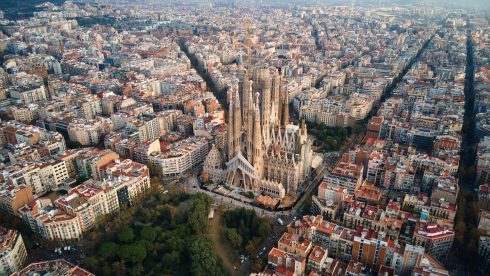ALTHOUGH England and Catalunya have the same patron saint, attitudes towards celebrating the historic tale of St George could not be more different.
For many proud Catalans, Dia de Sant Jordi (St George’s Day) is one of the most important celebrations in the calendar, unlike in the UK where it is nothing more than a footnote.
As a curious Englishman residing in Barcelona, and having been given the day off to delve into the celebrations, I thought it wise to venture into the heart of the city to find out what really goes on every April 23, and if there is anything us Brits could take from the Catalan way of honouring the feast of our shared patron saint.

But first, a history lesson.
The Catalan version of the legend of Sant Jordi says that in Montblanc, southern Catalunya, a fierce dragon had been terrorising the local population by demanding the daily sacrifice of one person each day, chosen at random.
One day, the local princess was the unlucky sacrifice-in-waiting before Sant Jordi stepped in to intervene, defeating the dragon.
After the brave knight valiantly slayed his dragon foe, a rosebush grew from the beast’s blood after it collapsed to the ground.
It was at this moment that a triumphant Sant Jordi plucked a rose from the bush and offered it to the princess.

It is for this reason that on Sant Jordi every year, the residents of Catalunya exchange roses with their loved ones.
The day takes on added importance because many people do not celebrate St Valentine’s Day, so Dia de Sant Jordi becomes the main day for celebrating love.
Yet that is not all – in 1929, a group of booksellers in Barcelona decided to head to the city’s famous thoroughfares to set up stands to promote their new releases.
The day they chose – April 23 – became World Book Day as it coincided with the death of two of the great icons of literature, William Shakespeare and Cervantes.
Tradition therefore dictates that, along with gifting a rose, Catalans exchange books as presents.

Whilst love and literature are the two main themes of the day, many other activities take place including live music, dances, poetry readings, workshops, recitals, street parties, kids activities and castells, the half-impressive, half-frightening human towers unique to Catalan culture.
My journey to discover an authentic Catalan Sant Jordi began at the top of Passeig de Gracia, one of Barcelona’s many famous boulevards which played host to the day’s celebrations.
Normally popular for its immense array of high-end designer shops, the 1.3km long avenue had been completely pedestrianised and converted into one seemingly never-ending book store.
Across the city, over 430 temporary stands had been erected to sell books and roses, with florists expected to cash in on the celebrations with the sale of over seven million roses – a third of annual turnover.

Evidence of this was obvious – as I walked along Barcelona’s sunlit streets, almost everyone appeared to be carrying a rose, either given as a gift by a loved one, or bought as a present.
The packaging of each and every rose was emblazoned with the senyera, the colours of the Catalan flag, which could also be spotted draped over thousands of balconies across the city.
Sant Jordi, as well as being a celebration of love and literature, has occupied an important position within the Catalan political consciousness as a day to defend and celebrate Catalan culture.

As I perused the thousands of books on offer, I was struck by how many (unfortunately for me and my as-yet lacklustre Catalan skills) were written in the region’s native dialect.
The people of Catalunya are immensely proud of their unique culture and identity – as the independence tussle over the last decade has shown – and Sant Jordi is viewed as one of greatest opportunities to celebrate this every year.
Thankfully for me, the range of literature on sale is immensely diverse, and as I strolled along the jam-packed streets I managed to pick up four books – one in English and three in Spanish – which have provided fascinating reading since.
As an extra incentive, hundreds of authors use Sant Jordi to offer book signings, with long queues snaking along the thoroughfares as locals vie to catch a glimpse of their favourite writer.

Aside from some of the great and good of Spanish and Catalan literature, books were signed by David Walliams, the popular British children’s author, and Aitana Bonmati, the FC Barcelona and Spain footballer who recently won the Women’s Ballon D’or after playing a starring role in Spain’s success at the 2023 World Cup.
Further down Passeig de Gracia, Casa Battló, one of the city’s most iconic landmarks built by the master architect Antonio Gaudi, was transformed into an eye-catching explosion of colour with the building’s facade covered in bright red roses.
On the other side of Plaça de Catalunya, the iconic Rambla was packed to the rafters with punters ambling aside more and more book shops.

It appeared that almost every single publishing house in Spain had set up a stall to flog their material – whether you were an avid fan of traditional literature, a bookish non-fiction lover, a child learning to read, a sports fanatic, a history geek, an art appreciator or even a Communist, there was a bookstand seemingly hand-designed for your needs and wants.
In the end, after my legs grew wary from the hour upon hour of traipsing up and down the bustling boulevards, I left, not just with four new books in my possession, but with an odd feeling of realisation and hope, that if us English weren’t so cynical and miserable and self-loathing, we too could perhaps enjoy such a simple yet thoroughly enjoyable day out.











